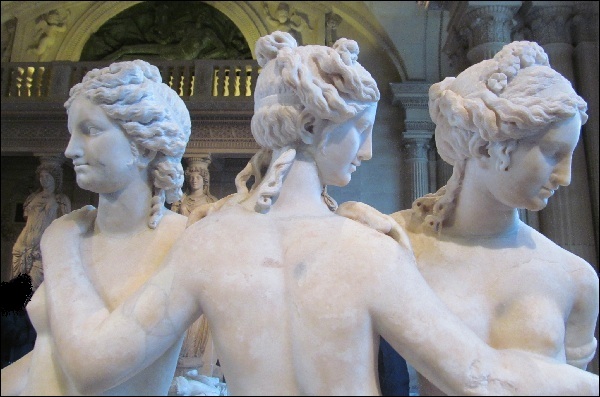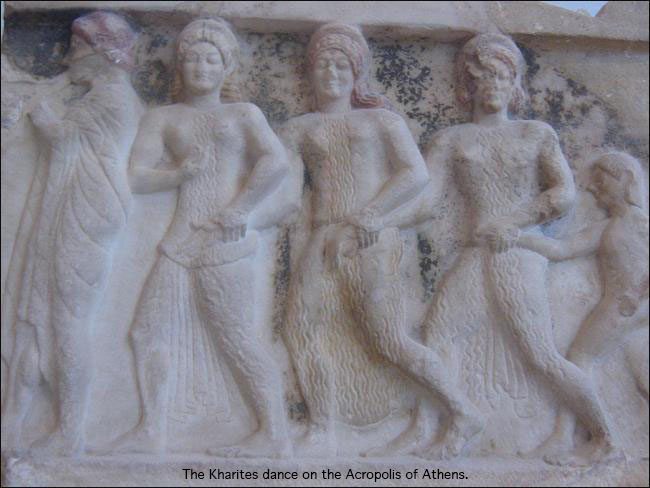
| Bibliography |
| Previous Page |
| Homepage |
| Site Search |
The Kharites are often called the Graces or the Charities. They are the three beautiful daughters of Zeus and Eurynome—Aglaia (Splendor), Euphrosyne (Festivity), and Thaleia (Rejoicing).
Zeus is a son of the Titans Kronos and Rhea ... he is considered to be the father of gods and men because his authority is inviolate on earth as well as on Mount Olympos. Eurynome is an Okeanid—one of the daughters of Okeanos (Ocean) and Tethys. She became the consort of Zeus ... their three daughters are the fair-cheeked Kharites.
In the distant past, the earth was inhabited entirely by men. Life was difficult, but in many ways blissful. The Rebel-God Prometheus wanted to give fire to the men but Zeus denied them that luxury. Prometheus stole fire from Zeus and gave it to the men on the earth. He was punished severely for his act of rebellion. Zeus also wanted to punish the men with a subtle and irresistible "gift" that would shatter their lives.
Zeus instructed the Immortals to create a woman ... her name would be Pandora, meaning All-Endowed. Zeus intended to give the deceptive gift to his cousin, Epimetheus, the brother of Prometheus.
Hephaistos, artificer of the Immortals, molded Pandora's body from earth into the likeness of a modest young girl ... Athene taught Pandora the skills of weaving and gave her dexterity ... Aphrodite, goddess of love, put a mist upon Pandora's head to engender longing and desire ... Hermes gave her treachery and shamelessness ... the Kharites and Peitho (Persuasion) gave her necklaces of gold ... the Horae (Seasons) put a halo of flowers on Pandora's head.
Prometheus warned Epimetheus not to accept gifts from Zeus but when Epimetheus saw Pandora, he could not resist her charms. When he accepted Pandora, he unleashed countless evils on the world. The only positive influence Pandora brought to the world of men was hope ... uncompromising hope in a world that oftentimes seemed harsh and unforgiving. Although women were designed as a curse to men, the only thing worse than marriage is for a man to live and die alone.
The story of the Quest for the Golden Fleece was eloquently told by Apollodorus Rhodius in his epic poem, Argonautika.
The Kharites made several robes for Aphrodite, goddess of love, but they are not described in detail ... however, there was another robe made by the Kharites that became an integral part of the Quest for the Golden Fleece ... it was a crimson robe made by the Kharites for the god Dionysos.
The Golden Fleece was from a flying ram that flew from Greece to Kolkhis on the eastern edge of the Black Sea. A young hero named Ieson (Jason) assembled the finest and bravest men in Greece to help him retrieve the fleece so he could claim the kingship of Iolkos ... his companions were called Argonauts ... named after their ship, the Argo.
When Ieson and the Argonauts began their long voyage to Kolkhis, they stopped on the island of Lemnos where the husbandless women of the island gladly welcomed them. The women of Lemnos had not become widows in the traditional way ... they had murdered the men of the island for their adulterous behavior ... now they were desperate for male companions ... the Argonauts arrived just in time to fulfill that role.
Ieson became the lover of Queen Hypsipyle. As he was leaving, Hypsipyle presented Ieson with the crimson robe that had been passed down from Dionysos to her father King Thoas. When Thoas fled the island in the midst of the man-killing frenzy, he gave the robe to his daughter Hypsipyle, who in turn gave it to Ieson as a token of her affection.
The robe is mentioned three times in the Argonautika. When Queen Hypsipyle gave the robe to Ieson, it was described as beautiful to look upon, with a texture that was irresistible to the touch. Hypsipyle told Ieson that the Kharites made the robe for Dionysos while he was on the island of Dia with Ariadne, daughter of King Minos of Krete. The robe emitted a fragrance reminiscent of the wine and ambrosia Dionysos and Ariadne shared when he wore the robe.
The second time the robe was mentioned was when Ieson wore the sacred garment as he was performing a ritual for the Roaring Goddess Hekate. The ceremony was solemn in order to display the greatest respect for the goddess so she would protect Ieson in his upcoming trials. King Aietes of Kolkhis told Ieson that he could have the Golden Fleece if he could prove his manhood by fighting a series of supernatural beasts. The only way to accomplish the seemingly impossible trials was to have the protection of Hekate ... wearing the sacred robe was necessary during the evocation ceremony to win the favor of the goddess.
The third instance where the robe was mentioned in the Argonautika was a circumstance much less noble than conjuring a goddess. After Ieson survived the trials of manhood Aietes demanded, the king would not surrender the Golden Fleece ... with the assistance of the king's daughter, Princess Medeia, Ieson stole the fleece and fled Kolkhis. The king sent his son Apsyrtos to bring Medeia and the fleece back to Kolkhis. When Apsyrtos had Ieson and Medeia cornered, the fugitives asked for a truce and a meeting to discuss their surrender. Ieson and Princess Medeia used the robe as a lure and a token of their good faith ... Apsyrtos accepted their offer and was cruelly murdered for his bad judgment. After that incident, the crimson robe made by the Kharites disappeared from the historical record.
As goddesses, the Kharites have dominions of their own but we often encounter them in their relationship with the goddess of love, Aphrodite. On one embarrassing occasion, Aphrodite was wearing a robe woven by the Kharites when she was caught being unfaithful to her husband Hephaistos. Aphrodite had been enjoying an intimate relationship with Ares, god of war, for quite some time before Hephaistos found out. When Helios (Sun), who sees all, pointed out the infidelity to Hephaistos, he constructed a clever trap around his bed. The unsuspecting lovers were ensnared before they knew what was happening.
Hephaistos summoned the Immortals from Mount Olympos to witness the spectacle. After he was satisfied that he would be paid reparations and that his wife had been properly humiliated, Hephaistos let Aphrodite go to Kypros so she could be attended by the Kharites. After bathing her, the Kharites anointed Aphrodite with ambrosial oil and dressed her in delightful clothing so that she might resume her loving duties.
In another instance, Aphrodite was wearing a robe the Kharites made for her when she was attacked on the battlefield during the Trojan War. Aphrodite and the other Immortals were in the habit of invisibly entering into the fighting at Troy to protect their semi-divine sons, or in some cases, just to contribute to the carnage. Aphrodite fought for the Trojans but the Grim Goddess Athene fought for the Achaians ... the two goddesses were not "enemies" but they were fierce rivals. Athene gave an Achaian commander named Diomedes the ability to see the Immortals on the battlefield ... she told him to avoid all the gods and goddesses except Aphrodite ... if he saw her, he was to stab her.
Aphrodite was busy protecting her son Aineias when Diomedes saw her ... his spear point pierced the divine robe and slashed Aphrodite's palm. It's odd that the only Immortal to be wounded by a mortal in the Trojan War was the goddess of love.
Homer, the author of the Iliad, used the beauty of the Kharites ironically to depict the horror of war when he described a dead Trojan soldier's skillfully braided hair as being lovely as the hair of the Kharites before it was splattered with blood and mingled with the dirt of the battlefield.
We have a curious incident in the Iliad where the goddess Hera offers to let Hypnos, god of sleep, marry Pasithea, "one of the younger Kharites," if he will cast a spell of slumber on Zeus so Poseidon, lord of the sea, can attack the Trojans. Pasithea is otherwise not mentioned as one of the Kharites ... in fact, Theogony by Hesiod states clearly that Eurynome and Zeus had three fair-cheeked daughters ... Aglaia, Euphrosyne, and Thaleia ... Aglaia being the youngest of the three.
Also, in Theogony, we learn that Hephaistos married Aglaia ... it's not clear whether this marriage was before or after his marriage to Aphrodite ... regardless, it's quite obvious that Hephaistos had impeccable taste in goddesses.

The Iliad
The Odyssey
Theogony
The Astronomy
Kypria
The Argonautika by Apollonius of Rhodes